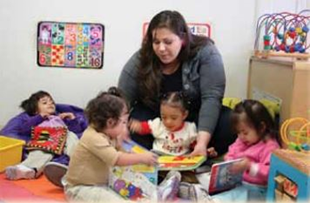17.2 Assessment
Early childhood education programs should have outcomes that relate to their philosophy and the objectives they have for children. As we examine the cycles of curriculum planning that we have completed, we can use that data to further inform curriculum planning and assess children’s developmental progress.[1]
Assessing to Inform Curriculum Planning
The challenge for teachers and others who plan early childhood curriculum is to determine how much assessment data to gather and how to use the resulting information. The key is to organize a sustainable infrastructure that facilitates gathering meaningful information on every child regularly and systematically.
- The best instructional assessment information is collected frequently and used continuously to inform curriculum and instruction decisions. Young children learn quickly, and regular monitoring of progress is necessary to document incremental improvements in skills and behaviors. Teachers and other adults are more likely to collect, interpret, and apply assessment data if the process is built into the daily classroom schedule and responsibilities.
- Assessment to inform and monitor instruction is most accurate if multiple sources are considered and multiple methods used. Because much of young children’s learning and development occurs outside classrooms, it is important that competencies and progress are considered in all contexts and environments. The richest results are obtained when the perspectives of parents, caregivers, teachers, specialists, and children themselves are combined. Assessment instruments that gather information by observation and report, and include components for parents to report on children’s developmental and academic progress, provide a helpful structure.
- Methods used to collect instructional assessment information should resemble ongoing instruction and the interactions of home, child care centers, and classrooms. There are valid concerns about the negative effects of testing on young children. One of the biggest advantages of assessment to inform and monitor instruction is that the process seldom necessitates individualized testing. Adults should be able to collect instructional assessment data using the same experiences designed to facilitate preschool learning in group activities, support parent/infant interactions at home, or provide instruction in primary classrooms.
- Assessment instruments should be criterion-referenced with items that reflect functional skills. Actual assessment items and administration procedures will vary depending on whether the focus is in development or early academics. Nonetheless, repeated measures of performance across a sequence of skills that reflects curriculum goals provides the best documentation of children’s progress. Assessment to inform and monitor instruction is only as good as the curriculum and instruction young children receive. Assessing what we teach and teaching what we assess is essential for meaningful instructional assessment.
- Instructional and classroom assessment instruments should ideally reflect a logical teaching sequence. Assessments to inform and monitor instruction are most useful if items are organized in a sequence that reflects major skills in the curriculum, along with prior knowledge and/or prerequisite skills. This organization maps the curriculum for teachers and provides guidance for selection of subsequent learning goals.
- Instructional assessment instruments and procedures must be culturally and linguistically relevant. If the basic skills represented in early developmental and academic curricula are functional and appropriate for young children, instructional assessments have the advantage of being able to incorporate familiar materials, people, routines, and important events of a child’s life. If using an assessment in which items are culturally inappropriate, it is vital that those are revised, and parents can suggest more familiar and appropriate materials and behaviors. It is especially important that English Language Learners not be penalized by materials or directions that confuse cultural and language differences with cognitive or academic delays.[2]

Pause to Reflect
What stood out to you about assessing to inform curriculum planning? What did you most agree with? What got your thinking a bit more? Was there anything you disagreed with or are unsure about?
Assessing Children
Each child and group of children will be at different points in their journey towards these program’s outcomes. Children come with a range of interests, understandings, family and community experiences, developmental pathways, temperaments, and dispositions.

Educators use their observations of children and feedback from children and families, as well as evaluations of learning and wellbeing to analyse and assess what children are able to do and areas for further development or progression. Learning stories, educator reflections, journals and child portfolios are strategies to not only document experiences, but also help educators become more familiar with the outcomes as they make frequent links from their documentation to the outcomes they have for children. [3]
California Specific Content
Consideration in Early Childhood Assessment
Early childhood professionals are feeling ever-increasing pressure to document learning outcomes in an era of standards, accountability, and achievement testing. In addition to parents, we are the people responsible for the well-being of young children. Many professionals have legitimate concerns about misuse of assessment practices and instruments, and the potential for inequitable consequences for the children in our programs. It is important to consider some implications of the unique nature of early development and learning:
Complete and meaningful assessment in early childhood necessitates an understanding of family context, including getting to know family language and culture, gathering developmental information from parents, and conducting home visits with parent approval. This principle applies to all youngsters and families, but is especially critical for children whose families may not share the language or some of the economic advantages of the dominant culture. Understanding family expectations and experience places a child’s behavior in context and can prevent harmful decisions that result from misinterpretation of assessment data (NAEYC, 2005).
Younger children present some complex challenges and require flexible procedures for gathering meaningful and useful assessment information. Constitutional variables such as fatigue, hunger, illness, and temperament can easily overshadow the abilities of a young child. Time of day, setting, testing materials and other situational factors also affect performance. The younger a child, the more likely he or she is to fall asleep, become distressed, refuse to comply with directions, or be distracted from assessment activities. Professionals should be prepared to modify activities, explore alternative procedures, and/or reschedule rather than risk gathering faulty information that compromises assessment results.

Young children learn by doing, and demonstrate knowledge and skills through action-oriented activities. Authentic assessment of youngsters as they participate in daily activities, routines, and interactions generally produces the most valuable information for assessment. To the extent possible, assessment methods should allow for observation of young children engaged in spontaneous behaviors in familiar settings and with familiar people.
More assessments and increased data do not necessarily result in better assessment information. Early childhood professionals should only gather information they need, and know ahead of time how they will use all the information collected. It is generally most desirable to identify a set of appropriate methods and instruments that provide necessary information, and refine the use of those procedures over time
Some assessment instruments and procedures are better than others. Factors such as purpose, content, reliability and validity, efficiency, cost, and availability of professional development are all more important than appealing packaging and effective advertising. Of primary importance is the quality of information gathered and the decisions made as a result of assessment. Ultimately, whatever assessments we conduct should benefit the children, families, and programs we serve.[4]
Pause to Reflect
If you could only choose one thing in the previous section Consideration in Early Childhood Assessment to share with others, what would you want to be sure people new about assessment of young children.
- Australian Government Department of Education (n.d.) Educator My Time, Our Place. Retrieved from files.acecqa.gov.au/files/National-Quality-Framework-Resources-Kit/educators_my_time_our_place.pdf ↵
- A Guide to Assessment in Early Childhood; Infancy to Age Eight. Washington State Office of Superintendent of Public Instruction, 2008. ↵
- Australian Government Department of Education (n.d.) Educator My Time, Our Place. Retrieved from files.acecqa.gov.au/files/National-Quality-Framework-Resources-Kit/educators_my_time_our_place.pdf ↵
- A Guide to Assessment in Early Childhood; Infancy to Age Eight. Washington State Office of Superintendent of Public Instruction, 2008. ↵

